标签:包括 检测 技术 细节 asc return import 不能 imp
反射可以在运行时动态获取变量的各种信息,比如变量的类型(type),类别(kind)
如果是结构体变量,还可以获取到结构体本身的信息(包括结构体的字段、方法)
通过反射,可以修改变量的值,可以调用关联的方法
使用反射,需要import(“reflect”)
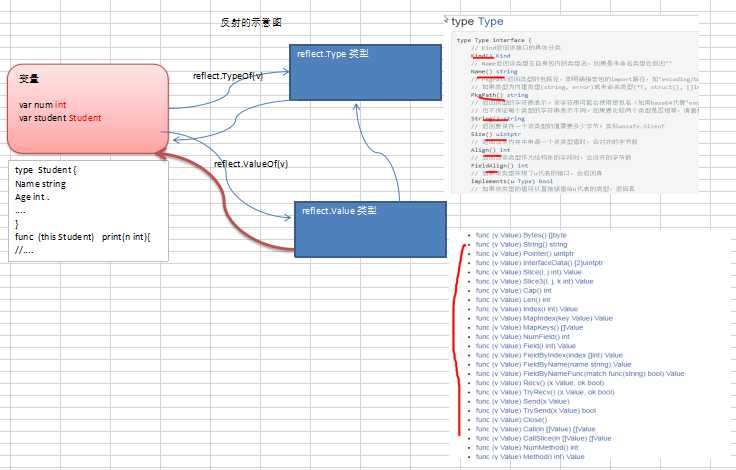
import (
"encoding/json"
"fmt"
)
type Monster struct {
Name string `json:"monsterName"`
Age int `json:"monsterAge"`
Sal float64 `json:"monsterSal"`
Sex string `json:"monsterSex"`
}
func main() {
m := Monster{
Name : "玉兔精",
Age : 20,
Sal : 888.99,
Sex : "female",
}
data,_ := json.Marshal(m)
fmt.Println("json result:", string(data))
}
输出结果:json result: {"monsterName":"玉兔精","monsterAge":20,"monsterSal":888.99,"monsterSex":"female"}思考问题:为什么
思考问题:
为什么序列化后,key - val的key值是结构体Tag的值,而不是字段的名称,比如:不是Name 而是:"monsterName":"玉兔精"
引出反射
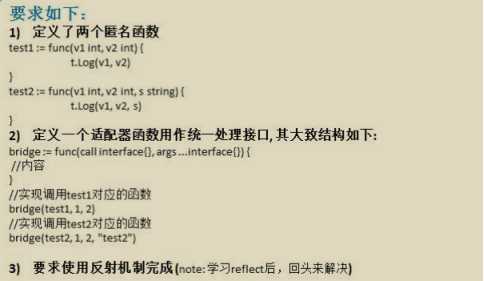
反射常见应用场景有以下两种
func bridge(funcPtr interface{}, args ...interface{})
第一个参数funcPtr以接口的形式传入函数指针,函数参数args以可变参数的形式传入,bridge函数中可以用反射来动态执行funcPtr函数
type Monster struct {
Name string `json:"monsterName"`
Age int `json:"monsterAge"`
Sal float64 `json:"monsterSal"`
Sex string `json:"monsterSex"`
}
reflect.TypeOf(变量名),获取变量的类型,返回reflect.Type类型
reflect.ValueOf(变量名),获取变量的值,返回reflect.Value类型reflect.Value是一个结构体类型。通过reflect.Value,可以获取到关于该变量的很多信息
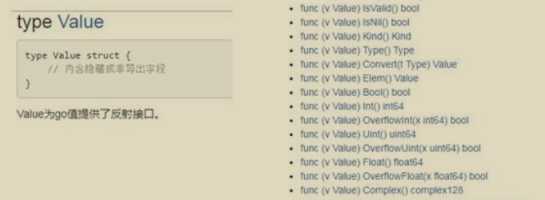
3)变量、interface{} 和 reflect.Value是可以相互转换的,这点在实际开发中,会经常使用到。画出示意图
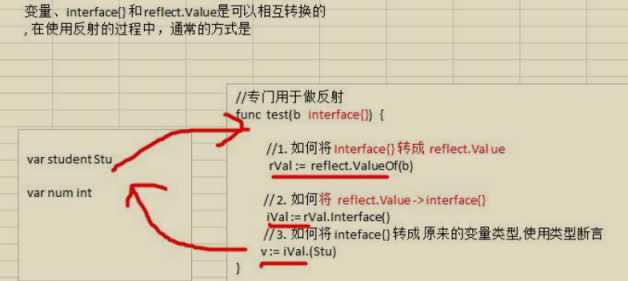

编写一个案例,演示对(结构体、基本数据类型、interface{}、reflect.Value)进行反射的基本操作,代码演示
import (
"fmt"
"reflect"
)
//专门演示反射
func reflectTest01(b interface{}) {
//通过反射获取的传入的变量的type,kind,值
//1. 先获取到reflect.Type
rTyp := reflect.TypeOf(b)
fmt.Println("rTyp = ", rTyp)
//2. 获取到reflect.Vakue
rVal := reflect.ValueOf(b)
n2 := 2 + rVal.Int()
fmt.Println("n2 = ", n2)
fmt.Printf("rVal = %v rVal type = %T\n", rVal, rVal)
//下面将rVal 转成interface{}
iV := rVal.Interface()
//将interface{}通过断言转成需要的类型
num2 := iV.(int)
fmt.Println("num2 = ", num2)
}
//专门演示反射[对结构体的反射]
func reflectTest02(b interface{}) {
//通过反射获取传入的变量的type,kind,值
//1. 先获取到reflect.Type
rTyp := reflect.TypeOf(b)
fmt.Println("rTyp = ", rTyp)
//2. 获取到reflect.Value
rVal := reflect.ValueOf(b)
//下面将rVal转成interface{}
iV := rVal.Interface()
fmt.Printf("iv = %v iv type = %T\n", iV, iV)
//将interface{}通过断言转成需要的类型
//这里,简单使用到检测的类型断言
//也可以使用switch的断言形式来做的更加的灵活
stu, ok := iV.(Student)
if ok {
fmt.Printf("stu.Name = %v\n", stu.Name)
}
}
type Student struct {
Name string
Age int
}
type Monster struct {
Name string
Age int
}
func main() {
//演示对(结构体、基本数据类型、interface{}、reflect.Value)进行反射的基本操作
//1. 先定义一个int
var num int = 100
reflectTest01(num)
//2. 定义一个Student的实例
stu := Student{
Name : "tom",
Age : 20,
}
reflectTest02(stu)
}
//rTyp = int
//n2 = 102
//rVal = 100 rVal type = reflect.Value
//num2 = 100
//rTyp = main.Student
//iv = {tom 20} iv type = main.Student
//stu.Name = tom
1)reflect.Value.Kind 获取变量的类别,返回的是一个常量
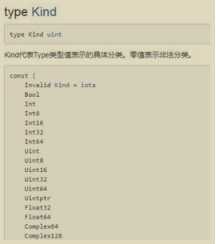
2) Type和Kind的区别
? Type是类型,Kind是类别,Type和Kind可能是相同的,也可能是不同的
? 比如:var num int = 10 num的Type是int,Kind也是int
? 比如:var stu Student stu的Type是pKg1.Student,Kind是struct


import (
"fmt"
"reflect"
)
func testInt(b interface{}) {
val := reflect.ValueOf(b)
fmt.Printf("val type = %T\n", val)
val.Elem().SetInt(110)
fmt.Printf("val = %v\n", val)
}
func main() {
var num int = 20
testInt(&num)
fmt.Println("num = ", num)
}
//val type = reflect.Value
//val = 0xc000054080
//num = 110

给一个变量 var v float64 = 1.2 ,请使用反射来得到它的reflect.Value,然后获取对应的Type,Kind和值,并将reflect.Value转换成interface{},再将interface{}转换成float64
看段代码,判断是否正确,为什么
import (
"fmt"
"reflect"
)
func main() {
var str string = "tom" // ok
fs := reflect.ValueOf(&str) // ok fs -> string
//fs.SetString("jack") //error
fs.Elem().SetString("jack")
fmt.Printf("%v\n", str)
}
//jack
import (
"fmt"
"reflect"
)
//定义一个Monster结构体
type Monster struct {
Name string `json:"name"`
Age int `json:"monster_age"`
Score float32 `json:"成绩"`
Sex string
}
//方法,返回两个数的和
func (s Monster) GetSum(n1, n2 int) int {
return n1 + n2
}
//方法,接收四个值,给s赋值
func (s Monster) Set(name string, age int, score float32, sex string) {
s.Name = name
s.Age = age
s.Score = score
s.Sex = sex
}
//方法,显示s的值
func (s Monster) Print() {
fmt.Println("---start---")
fmt.Println(s)
fmt.Println("---end---")
}
func TestStruct(a interface{}) {
//获取reflect.Type类型
typ := reflect.TypeOf(a)
//获取reflect.Value类型
val := reflect.ValueOf(a)
//获取到a对应的类别
kd := val.Kind()
//如果传入的不是struct,就退出
if kd != reflect.Struct {
fmt.Println("expect struct")
return
}
//获取到该结构体有几个字段
num := val.NumField()
fmt.Printf("struct has %d fields \n", num) //4
//变量结构体的所有字段
for i := 0; i < num; i++ {
fmt.Printf("Field %d: 值为=%v\n", i, val.Field(i))
//获取到struct标签,注意需要通过reflect.Type来获取tag标签的值
tagVal := typ.Field(i).Tag.Get("json")
//如果该字段于tag标签就显示,否则就不显示
if tagVal != "" {
fmt.Printf("Field %d: tag 为 = %v\n", i, tagVal)
}
}
//获取到该结构体有多少个方法
numOfMethod := val.NumMethod()
fmt.Printf("struct has %d methods \n", numOfMethod)
//var params []reflect.Value
//方法的排序默认是按照函数名的排序(ASCII码)
val.Method(1).Call(nil)//获取到第二个方法,调用它
//调用结构体的第1个方法Method(0)
var params []reflect.Value //声明了[]reflect.Value
params = append(params, reflect.ValueOf(10))
params = append(params, reflect.ValueOf(40))
res := val.Method(0).Call(params) // 传入的参数是[]reflect.Value ,返回[]reflect.Value
fmt.Println("res = ", res[0].Int()) //返回结果,返回的结果是[]reflect.Value
}
func main() {
//创建了一个Monster实例
var a Monster = Monster{
Name: "黄鼠狼精",
Age: 400,
Score: 30.8,
}
//将Monster实例传递给TestStruct函数
TestStruct(a)
}
//struct has 4 fields
//Field 0: 值为=黄鼠狼精
//Field 0: tag 为 = name
//Field 1: 值为=400
//Field 1: tag 为 = monster_age
//Field 2: 值为=30.8
//Field 2: tag 为 = 成绩
//Field 3: 值为=
//struct has 3 methods
//---start---
//{黄鼠狼精 400 30.8 }
//---end---
//res = 50
使用反射的方式来获取结构体的tag标签,遍历字段的值,修改字段值,调用结构体方法(要求:通过传递地址的方式完成,在前面案例上修改即可)
定义了两个函数test1和test2,定义一个适配器函数用作统一处理接口
使用反射操作任意结构体类型
使用反射创建并操作结构体
编写一个Cal结构体,有两个字段Num1和Num2
方法GetSub(name string)
使用反射遍历Cal结构体所有的字段信息
使用反射机制完成对GetSub的调用,输出形式为”tom 完成了减法运算,8 - 3 = 5”
标签:包括 检测 技术 细节 asc return import 不能 imp
原文地址:https://www.cnblogs.com/zisefeizhu/p/12643858.html